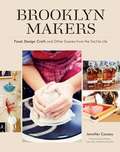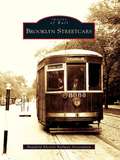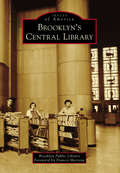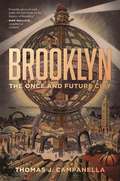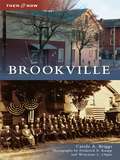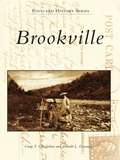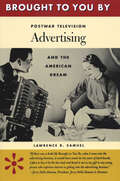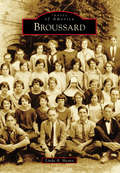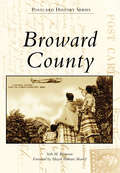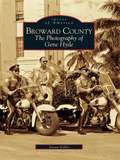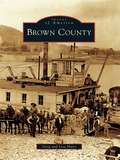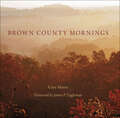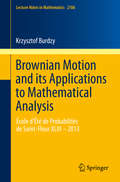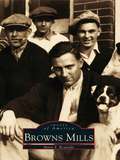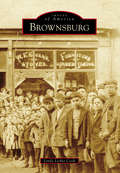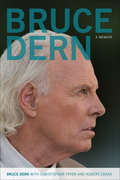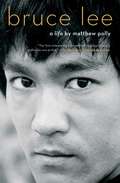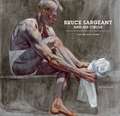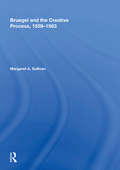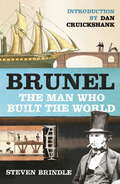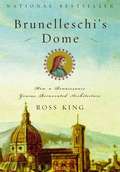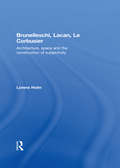- Table View
- List View
Brooklyn Makers
by Jennifer CauseyA creative renaissance blooms in Brooklyn. At its heart is a thriving community of artisans producing a remarkable variety of handmade goods. In Brooklyn Makers, photographer Jennifer Causey captures the spirit of this homegrown movement by documenting thirty of the borough's most celebrated craftsmen. This eclectic mix of established and up-and-coming makers includes bakers, ceramic artists, clothing designers, florists, distillers, and more. With an eye for small details, Causey's charming photographs reveal each artisan at work in their own space. Her lively interviews reveal what inspires them, keeps them motivated, and their thoughts on the city where they live and work.
Brooklyn Streetcars
by Branford Electric Railway AssociationIn the summer of 1854, the Brooklyn City Railroad opened four separate streetcar lines. The lines were introduced here several years before they were brought to larger cities, such as Baltimore, Boston, and Philadelphia, demonstrating the city's modernization and ingenuity. From its first introduction, Brooklyn had one of the nation's largest urban transit systems. With the advent of streetcars, the population in Brooklyn grew from about 139,000 to over 2.5 million by the time streetcars were retired. The street railway blended mobility with innovation, prompting one-third of New York City's population to call Brooklyn home.
Brooklyn's Central Library (Images of America)
by Francis Morrone Brooklyn Public LibraryBrooklyn, New York, is home to the Brooklyn Public Library, the fifth-largest library system in the United States, with 60 neighborhood branches serving the 2.5 million residents of the borough. The Central Library--the main hub of this far-reaching institution--has, for 75 years, occupied a prime triangle of land at Brooklyn's Grand Army Plaza. Originally proposed in 1888, the unique Art Deco building with an "open book" design was not completed until 53 years later in 1941. Since then, the library has seen millions of eager readers pass through its iconic gilded doorway. While the technologies of learning have changed dramatically in the years since the Central Library opened, the mission of the institution remains the same--to ensure the preservation and transmission of society's knowledge, history, and culture, and to provide the people of Brooklyn with free and open access to information for education, recreation, and reference.
Brooklyn: The Once and Future City
by Thomas CampanellaAn unprecedented history of Brooklyn, told through its places, buildings, and the people who made them, from the early seventeenth century to todayAmerica's most storied urban underdog, Brooklyn has become an internationally recognized brand in recent decades—celebrated and scorned as one of the hippest destinations in the world. In Brooklyn: The Once and Future City, Thomas J. Campanella unearths long-lost threads of the urban past, telling the rich history of the rise, fall, and reinvention of one of the world’s most resurgent cities.Spanning centuries and neighborhoods, Brooklyn-born Campanella recounts the creation of places familiar and long forgotten, both built and never realized, bringing to life the individuals whose dreams, visions, rackets, and schemes forged the city we know today. He takes us through Brooklyn’s history as homeland of the Leni Lenape and its transformation by Dutch colonists into a dense slaveholding region. We learn about English émigré Deborah Moody, whose town of Gravesend was the first founded by a woman in America. We see how wanderlusting Yale dropout Frederick Law Olmsted used Prospect Park to anchor an open space system that was to reach back to Manhattan. And we witness Brooklyn’s emergence as a playland of racetracks and amusement parks celebrated around the world.Campanella also describes Brooklyn’s outsized failures, from Samuel Friede’s bid to erect the world’s tallest building to the long struggle to make Jamaica Bay the world’s largest deepwater seaport, and the star-crossed urban renewal, public housing, and highway projects that battered the borough in the postwar era. Campanella reveals how this immigrant Promised Land drew millions, fell victim to its own social anxieties, and yet proved resilient enough to reawaken as a multicultural powerhouse and global symbol of urban vitality.
Brookville
by Wrayanne L. Clapie Carole A. Briggs Frederick E. KnappBrookville photographer Frederick E. Knapp documented the events, people, and places of Brookville, the seat of Jefferson County, between 1898 and 1945. Teacher and amateur photographer Wrayanne L. Clapie revisited those sites in 2008. Now a federally registered historic district, Brookville's Main Street buildings, businesses and industries, schools, churches, and homes typify architecture during the last part of the 19th century and life during the first half of the 20th century, illustrating both change and preservation.
Brookville
by Craig T. Chappelow Donald L. DunawayPlatted in 1808 on a strip of land between the confluence of the East and West Forks of the Whitewater River, Brookville is one of the oldest and most picturesque towns in Indiana. The authors have assembled more than 200 historic postcards, contributed by local residents and collectors, that tell the story of Brookville's people and places. Many of the scenes depicted in Brookville postcards show homes, busy factories, and rural scenes that have long since disappeared. Browsing through these images gives an indication of the way Brookville used to be. Others scenes are easily recognizable today and show how the citizens of the town have preserved some of its most important landmarks.
Brought to You By: Postwar Television Advertising and the American Dream
by Lawrence R. SamuelThis book is a history of how television advertising rose to become a defining force in American culture in the two decades after World War II.
Brought to You By: Postwar Television Advertising and the American Dream
by Lawrence R. Samuel&“A lively history&” of how TV advertising became a defining force in American culture between 1946 and 1964(Technology and Culture). The two decades following World War II brought television into homes and, of course, television commercials. Those commercials, in turn, created an image of the postwar American Dream that lingers to this day. This book recounts how advertising became a part of everyday lives and national culture during this midcentury period, not only reflecting consumers&’ desires but shaping them, and broadcasting a vivid portrait of comfort, abundance, ease, and happy family life and, of course, keeping up with the Joneses. As the author asserts, it&’s nearly impossible to understand our culture without contemplating these visual celebrations of conformity and consumption, and this insightful, entertaining volume of social history helps us do just that.
Broussard (Images of America)
by Linda A. MeauxAs early as 1765, Acadians began to settle near St. Martinville in the center of an area known as Côte Gelée, or "Frozen Hill," due to seasonal cold temperatures that covered the Mississippi River with ice. These early settlers were exiles from Acadie (now Nova Scotia, Canada). They established farms that, in the early 1800s, became interspersed among expanding sugar plantations. With a motto of "Where our rich culture defines us," Broussard is one of the fastest growing cities in Louisiana today. Embracing its past has made way for Broussard's competitive spirit that positions its leaders in not only the state, but also the world. The Billeaud Sugar Mill, which supported the community for many years, has now diversified into land acquisitions. The St. Julien families, identified for many generations with agricultural, professional, and political interests, have long-standing ties to the community, as do sports figures such as National League umpire Greg Bonin and two Blanchard siblings who competed in the Junior Olympics.
Broward County: For More Than Ninety Years Broward County's City Of Choice (Postcard History Series)
by Seth H. Bramson Mayor Barbara ShariefBroward County came into existence on October 1, 1915, when Dade and Palm Beach Counties were partitioned to form a new county. Named for early-20th-century Florida governor Napoleon Bonaparte Broward, the county has grown to become renowned for nationally acclaimed restaurants, residential areas, colleges, universities, and shopping along Las Olas Boulevard in Fort Lauderdale. A major American metropolitan area, Broward County today is home to a branch of Florida International University, as well as the campuses of Nova Southeastern University, Broward College, and Florida Atlantic University. As of 2016, the population of Broward County was approximately 1.8 million people, making it Florida�s second-most populous county and the 17th-most populous in the United States.
Broward County: The Photography of Gene Hyde
by Susan GillisIn 1915, the South Florida communities of Fort Lauderdale, Dania, Pompano, Hallandale, Deerfield, and Davie joined together to form a county. They named it Broward, in honor of the governor whose Everglades drainage program had brought them such prosperity. Today, Broward is Florida's second largest county, with 1.6 million people. Photographer Aaron Eugene Hyde came to Fort Lauderdale in 1933, at the age of 16, to begin a 40-year career, serving as one of the county's few professional photographers and the photographer for the Broward edition of the Miami Herald. Gene recorded fascinating people, places, and times pivotal in the county's development. His photos evoke nostalgia for the not-that-distant past, a way of life Broward County residents will never see again.
Brown County
by Lisa Haitz Greg HaitzThe history of Brown County has been shaped largely by the Ohio River. It has allowed farmers and industries to transport their products and provided recreation, entertainment, and travel opportunities to the residents of the community. Even though flooding of the river brought destruction many times, it also enabled freedom for thousands of slaves. Under abolitionist leaders like John Rankin and John Parker, parts of Brown County became known as the "Grand Central Station" of the Underground Railroad. Interesting and notable Brown County natives include Ulysses S. Grant, who grew up to command one of the largest armies ever assembled and later became president of the United States; Col. Charles Young, the third African American to graduate from West Point and a military attache to Liberia; Rosie Riles, better known as "Aunt Jemima"; and Joe Smith, who inadvertently helped Louis Armstrong's career, also hailed from this great county.
Brown County Mornings
by Gary Moore“I spent many days of my childhood in the woods of southern Indiana. Each [photograph] brings memories rushing back with a flush of nostalgia and pleasure.” —Tim FitzharrisRolling hills, rich forests, and beautiful vistas have made Brown County, Indiana, a favorite haunt of painters and ordinary tourists. In this gorgeous collection, landscape photographer Gary Moore reveals the spirit of the place in the morning hours as it awakens to the new day.Complementing Moore’s wonderful photographs is a text by James P. Eagleman, one of the area’s lifelong naturalists, which showcases the county’s unique flora and fauna. Included with more than one hundred color landscape photographs are Moore’s tips on composition, atmosphere, and lighting, encouraging readers to test their creativity with whatever equipment they possess. A book to treasure, Brown County Mornings beckons visitors to enjoy this magical place at any time of day or year.
Brownian Motion and its Applications to Mathematical Analysis: École d'Été de Probabilités de Saint-Flour XLIII – 2013 (Lecture Notes in Mathematics #2106)
by Krzysztof BurdzyThese lecture notes provide an introduction to the applications of Brownian motion to analysis and more generally, connections between Brownian motion and analysis. Brownian motion is a well-suited model for a wide range of real random phenomena, from chaotic oscillations of microscopic objects, such as flower pollen in water, to stock market fluctuations. It is also a purely abstract mathematical tool which can be used to prove theorems in "deterministic" fields of mathematics. The notes include a brief review of Brownian motion and a section on probabilistic proofs of classical theorems in analysis. The bulk of the notes are devoted to recent (post-1990) applications of stochastic analysis to Neumann eigenfunctions, Neumann heat kernel and the heat equation in time-dependent domains.
Browns Mills
by Marie F. ReynoldsHalfway between the bustling streets of Philadelphia and the serenity of the New Jersey Shore lies Browns Mills, New Jersey. Nestled within its rich pine trees and dark lakes is the legacy of those who sought nature's healing properties, social status, and a summer refuge for more than two generations.Their stories and faces make up the exciting collection in Browns Mills. Tales of those who came seeking natural spring waters to avoid le grippe became the foundation for the grand hotels that existed in the early nineteenth century. The annals of others in search of a lakefront lot as their own private hideaway create the framework for a modern town that remains dotted with quaint summer cottages.Their stories, at last, are combined in Browns Mills to form a chronicle of life in this Pinelands community from 1820 through the 1970s.
Brownsburg (Images of America)
by Linda Lichte CookIn 1835, William Harris sectioned off his land--the area now known as Main and Green Streets in Brownsburg--for the purpose of establishing a town. Harris used beech trees, elm trees, and hickory stumps to define the town's boundaries; he called it Harrisburg. The name Harrisburg was already in use elsewhere in Indiana, so Brownsburg, which paid homage to early settler James B. Brown, was selected as an alternative. Brownsburg's railroad station, located between Indianapolis and Crawfordsville, positioned the farming community for dramatic growth. As new settlers arrived, new businesses, mills, and factories also began to open. Today, Brownsburg continues to grow, and the community is known for its engineering and racing industries and its first-rate schools.
Bruce Dern: A Memoir (Screen Classics)
by Robert Crane Christopher Fryer Bruce DernThis memoir by the Academy Award nominee “proves that Dern off-screen is every bit as unpredictable, compelling and explosively honest as he is onscreen” (Newsday).One of Hollywood’s biggest personalities, Bruce Dern is not afraid to say what he thinks. He has left an indelible mark on numerous projects, from critically acclaimed films to made-for-TV movies and television series. His notable credits include The Great Gatsby, The 'Burbs, Monster, Django Unchained, and Nebraska, for which he won the Best Actor award at the 2013 Cannes Film Festival. He also earned Oscar nominations for Best Supporting Actor in Coming Home and for Best Actor in Nebraska.In Bruce Dern: A Memoir, Christopher Fryer and Robert Crane help the outspoken star frame the fascinating tale of his life in Hollywood. Dern details the challenges he faced as an artist in a cutthroat business, his struggle against typecasting, and his thoughts on and relationships with other famous figures, including Elia Kazan, Alfred Hitchcock, Jack Nicholson, Paul Newman, Bob Dylan, Matt Damon, Jane Fonda, John Wayne, and Tom Hanks. He also explores the impact of his fame on his family and discusses his unique relationship with his daughter, actress Laura Dern.Edgy and uncensored, this memoir—filled with “amusing, illuminating, and occasionally heartrending anecdotes” (Philadelphia Inquirer)—is a wild ride and an insider’s view of fifty years in the film industry.
Bruce Lee: A Life
by Matthew PollyThe &“definitive&” (The New York Times) biography of film legend Bruce Lee, who made martial arts a global phenomenon, bridged the divide between eastern and western cultures, and smashed long-held stereotypes of Asians and Asian-Americans. Forty-five years after Bruce Lee&’s sudden death at age thirty-two, journalist and bestselling author Matthew Polly has written the definitive account of Lee&’s life. It&’s also one of the only accounts; incredibly, there has never been an authoritative biography of Lee. Following a decade of research that included conducting more than one hundred interviews with Lee&’s family, friends, business associates, and even the actress in whose bed Lee died, Polly has constructed a complex, humane portrait of the icon. Polly explores Lee&’s early years as a child star in Hong Kong cinema; his actor father&’s struggles with opium addiction and how that turned Bruce into a troublemaking teenager who was kicked out of high school and eventually sent to America to shape up; his beginnings as a martial arts teacher, eventually becoming personal instructor to movie stars like James Coburn and Steve McQueen; his struggles as an Asian-American actor in Hollywood and frustration seeing role after role he auditioned for go to a white actors in eye makeup; his eventual triumph as a leading man; his challenges juggling a sky-rocketing career with his duties as a father and husband; and his shocking end that to this day is still shrouded in mystery. Polly breaks down the myths surrounding Bruce Lee and argues that, contrary to popular belief, he was an ambitious actor who was obsessed with the martial arts—not a kung-fu guru who just so happened to make a couple of movies. This is an honest, revealing look at an impressive yet imperfect man whose personal story was even more entertaining and inspiring than any fictional role he played onscreen.
Bruce McDonald's 'Hard Core Logo'
by Paul McewanConsistently ranked as one of the best Canadian movies of all time, punk-rock mockumentary Hard Core Logo (1996) documents the last-ditch reunion tour of an aging rock band led by vocalist Joe Dick (Hugh Dillon). Well received by critics at the time of its release, the film continues to enjoy a devoted international cult following.This entertaining analysis of Hard Core Logo explores many of the film's key themes, including the responsibility of documentary filmmakers to their subjects, the development of close male relationships, and the relationship between art and commerce in Canada, especially for touring musicians. Paul McEwan examines Hard Core Logo in the context of other adaptations of Michael Turner's 1993 novel of the same name, as well as against other films from McDonald's celebrated career. Featuring interviews with McDonald himself and others involved in the film, Bruce McDonald's 'Hard Core Logo' provides an engaging look at one of Canada's most mythologized movies.
Bruce Sargeant and His Circle: Figure and Form
by Mark Beard Thomas SokolowskiPainter Mark Beard is a master of fiction. Working in the 1920s style of his imaginary gay great-uncle Bruce Sargeant, Beard creates images of athletes in various stages of dress and undress. This archly homoerotic, exquisitely rendered body of work is rounded out with paintings by Bruce's circle of friends and associates: his Classicist teacher, Modernist lesbian best friend, and Abstract Expressionist art-school rival. Critical essays, remembrances from New York society members, and other ephemera from this lively quartet of fictional characters create an enticing journey into history, literature, and art.
Bruegel and the Creative Process, 1559-1563
by Margaret A. SullivanThe art Bruegel produced between 1559 and 1563 presents a rare opportunity to investigate a concentrated period of productivity by one of the world's greatest artists. In this brief period Bruegel produced some of his most original works-the first pictorial collection of contemporary customs in Carnival and Lent, the first painting with children's activities as its subject in Children's Games, the first large-scale painting of a proverb collection, the unique and enigmatic Dulle Griet (Mad Meg), and the extraordinary Triumph of Death, his disturbing vision of men and women fighting off the onslaught of death. In this comprehensive study, Margaret A. Sullivan accounts for this burst of creativity, its intensity, innovation and brevity, by taking all aspects of the creative process into consideration-from the technical demands of picture-making to the constraints imposed by the dangerous religious and political situation.
Brunel: The Man Who Built The World (Phoenix Press Ser.)
by Dan Cruickshank Steven BrindleA celebration of the life and engineering achievements of Isambard Kingdom Brunel by two of the world's foremost authorities.In his lifetime, Isambard Kingdom Brunel towered over his profession. Today, he remains the most famous engineer in history, the epitome of the volcanic creative forces which brought about the Industrial Revolution - and brought modern society into being.Brunel's extraordinary talents were drawn out by some remarkable opportunities - above all his appointment as engineer to the new Great Western Railway at the age of 26 - but it was his nature to take nothing for granted, and to look at every project, whether it was the longest railway yet planned, or the largest ship ever imagined, from first principles. A hard taskmaster to those who served him, he ultimately sacrificed his own life to his work in his tragically early death at the age of 53. His legacy, though, is all around us, in the railways and bridges that he personally designed, and in his wider influence.This fascinating new book draws on Brunel's own diaries, letters and sketchbooks to understand his life, times, and work.
Brunel: The Man Who Built the World
by Steven BrindleA celebration of the life and engineering achievements of Isambard Kingdom Brunel by two of the world's foremost authorities.In his lifetime, Isambard Kingdom Brunel towered over his profession. Today, he remains the most famous engineer in history, the epitome of the volcanic creative forces which brought about the Industrial Revolution - and brought modern society into being.Brunel's extraordinary talents were drawn out by some remarkable opportunities - above all his appointment as engineer to the new Great Western Railway at the age of 26 - but it was his nature to take nothing for granted, and to look at every project, whether it was the longest railway yet planned, or the largest ship ever imagined, from first principles. A hard taskmaster to those who served him, he ultimately sacrificed his own life to his work in his tragically early death at the age of 53. His legacy, though, is all around us, in the railways and bridges that he personally designed, and in his wider influence.This fascinating new book draws on Brunel's own diaries, letters and sketchbooks to understand his life, times, and work.
Brunelleschi's Dome: How a Renaissance Genius Reinvented Architecture
by Ross KingBrunelleschi's Dome is the story of how a Renaissance genius bent men, materials, and the very forces of nature to build an architectural wonder we continue to marvel at today. Denounced at first as a madman, Brunelleschi was celebrated at the end as a genius. He engineered the perfect placement of brick and stone, built ingenious hoists and cranes (among some of the most renowned machines of the Renaissance) to carry an estimated 70 million pounds hundreds of feet into the air, and designed the workers' platforms and routines so carefully that only one man died during the decades of construction--all the while defying those who said the dome would surely collapse and his own personal obstacles that at times threatened to overwhelm him. <p><p> This drama was played out amid plagues, wars, political feuds, and the intellectual ferments of Renaissance Florence-- events Ross King weaves into the story to great effect, from Brunelleschi's bitter, ongoing rivalry with the sculptor Lorenzo Ghiberti to the near catpure of Florence by the Duke of Milan. King also offers a wealth of fascinating detail that opens windows onto fifteenth-century life: the celebrated traditions of the brickmaker's art, the daily routine of the artisans laboring hundreds of feet above the ground as the dome grew ever higher, the problems of transportation, the power of the guilds. <p> Even today, in an age of soaring skyscrapers, the cathedral dome of Santa Maria del Fiore retains a rare power to astonish. Ross King brings its creation to life in a fifteenth-century chronicle with twenty-first-century resonance.
Brunelleschi, Lacan, Le Corbusier: Architecture, Space and the Construction of Subjectivity
by Lorens HolmThis well-argued, analytic text provides a greater understanding of spatial issues in the field of architecture. Re-interpreting the fifteenth century demonstration of perspective, Lorens Holm puts it in relation to today’s theories of subjectivity and elaborates for the first time the theoretical link between architecture and psychoanalysis.Divided into three sections, Brunelleschi, Lacan, Le Corbusier argues that perspective remains the primary and most satisfying way of representing form, because it is the paradigmatic form of spatial consciousness. Well-illustrated with over 100 images, this compelling book is a valuable study of this key aspect of architectural study and practice, making it an essential read for architects in their first year or their fiftieth.
